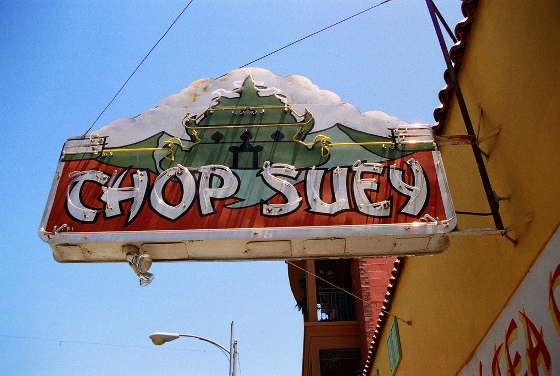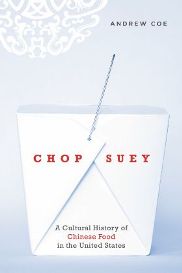
Andrew Coe, a writer for Saveur, Gastronomica, The New York Times, and others, takes on the history of Chinese food in America in his latest book, Chop Suey. The title dish is more American than Chinese, and was, at the turn of the last century, the height of cuisine, before becoming a popular sandwich substitute and dinner-table standard. Below, Coe adapts a story told in Chop Suey for Zócalo, about the man who pushed American tastes beyond chop suey toward diverse Chinese dishes – President Richard Nixon.
Raising the Bamboo Curtain
 If we remember anything about President Nixon’s eating habits it’s that he liked to eat low-fat cottage cheese doused with ketchup. (He hated the stuff but persevered with typical Nixonian determination because he wanted to look good on TV.) This was true, but he wasn’t exactly a culinary primitive: He also had a taste for expensive steak, vintage wine, and fine French cuisine. Nevertheless, it’s with some surprise that we have to admit that Richard Nixon inadvertently brought about a revolution in American culinary history.
If we remember anything about President Nixon’s eating habits it’s that he liked to eat low-fat cottage cheese doused with ketchup. (He hated the stuff but persevered with typical Nixonian determination because he wanted to look good on TV.) This was true, but he wasn’t exactly a culinary primitive: He also had a taste for expensive steak, vintage wine, and fine French cuisine. Nevertheless, it’s with some surprise that we have to admit that Richard Nixon inadvertently brought about a revolution in American culinary history.
During Nixon’s first term, he decided to reopen relations with Communist China, which the United States had shunned for almost two decades. The point of this initiative was to further separate China from the Soviet Union, aid in the negotiations to wind down the Vietnam War, and not coincidentally, help insure his reelection in 1972. However, as his groundbreaking visit drew near, he realized that media attention on such touchy issues as the status of Taiwan would be dangerous. To distract the press, he decided to focus their attention on the less substantial aspects of the trip, particularly the Chinese food he enjoyed at a series of elaborate banquets in Beijing and other cities.
On the flight to China, the passengers on Air Force One carried fat briefing books filled with information on what they would encounter on the table. The Americans were warned that they might be served shark’s fins, bird’s nests, sea cucumbers, snake, and who knows what else. “Fortunately,” the writer assured them, “one’s taste buds are a more reliable guide to the excellence of these delicacies than one’s imagination.” Chinese table etiquette was especially tricky: “The Chinese relish their cuisine. You should not be offended at the noisy downing of soups, or even at burping after a meal.” And what do you talk about with the ageing Long March veteran who is your tablemate? Why food, of course: “They react with much pleasure to compliments about the truly remarkable variety of tastes, textures, and aromas in Chinese cuisine.” However: “It is wise not to say a particular dish is ‘good’ or ‘interesting’ when in fact you do not like it, as your hosts, in an effort to please, may serve you extra portions to your embarrassment.”
On the night of February 21, 1972, a phalanx of TV cameras were aimed at the center table in Beijing’s Great Hall of the People. In the host’s seat sat Communist China’s Premier Zhou Enlai, flanked by President Nixon, his face incongruously brightened with pancake makeup, and Mrs. Nixon, her blonde bouffant glowing in the bright light. Premier Zhou unfolded his napkin onto his lap and picked up his chopsticks–the signal that the banquet had begun. President Nixon fitted his chopsticks into his hand, plucked a morsel of appetizer from one of the plates, gazed at it quizzically for a moment, put it into his mouth and began to chew. Millions of people around the world watched him eat Chinese food.
The United States then was at the tail end of the chop suey and chow mein era. Americans were deserting the ubiquitous Chinese-American restaurants for fast food hamburgers and pizza. In cities like New York, San Francisco, and Washington, D.C., a handful of restaurants offered an alternative: high-end Cantonese banquet fare, “northern” or “Mandarin” food (terms which encompassed anything but Cantonese food), and Sichuan cuisine. When American diners saw their president deftly eating Peking duck with chopsticks, it triggered in them an insatiable desire to eat “authentic” Chinese food. Within days, the lines were out the door for Washington, D.C.’s Peking Restaurant, while the nearby chop suey joints were half deserted.
This craving for Chinese food like they served in China was accompanied by a sea change in American tastes. Diners were growing tired of the bland and overcooked food they had been enjoying for decades. They didn’t want dishes like creamed chipped beef on toast anymore; their taste buds now demanded something spicy and crunchy: Kung Pao shrimp. From February 21st on, Chinatown restaurants were mobbed. In fact, during the 1970s recession, they were the one bright spot in the restaurant industry doldrums. Inspired by Nixon’s trip, foodies also discovered Hunan food and “real” Cantonese cuisine, particularly dim sum. (Thanks to immigration, American Chinese communities today also boast restaurants offering the food of Fujian, Shanghai, Wenzhou, Beijing, Dongbei, Qingdao, Singapore, Korea, India, Cuba, and on and on.) Outside of Chinatowns, chop suey and egg foo young were replaced by a new list of standard dishes: hot and sour soup, moo shu pork, General Tso’s chicken, orange beef, chicken with broccoli, and fried dumplings.
However, as these dishes spread to eateries across the United States, something strange happened to the recipes. Driven by restaurateurs’ need to fill their tables, chefs adapted them to American tastes. In the original recipe (invented by a Hunanese chef in Taiwan), General Tso’s chicken is a light and spicy concoction. In the new version, the chicken chunks were deep fried in batter and covered with a mildly spicy, often cloyingly sweet sauce. Today, many of these dishes are so divorced from their roots that visitors from China wouldn’t recognize them as their native cuisine. Nevertheless, the success of this menu has driven a Chinese restaurant boom; over 40,000 Chinese eateries, the vast majority serving Americanized food, cover the nation. Nixon’s 1972 trip changed the way we think of Chinese food, just not how we might have hoped.
*Photo of Chop Suey restaurant courtesy Chris Jackson.




Send A Letter To the Editors